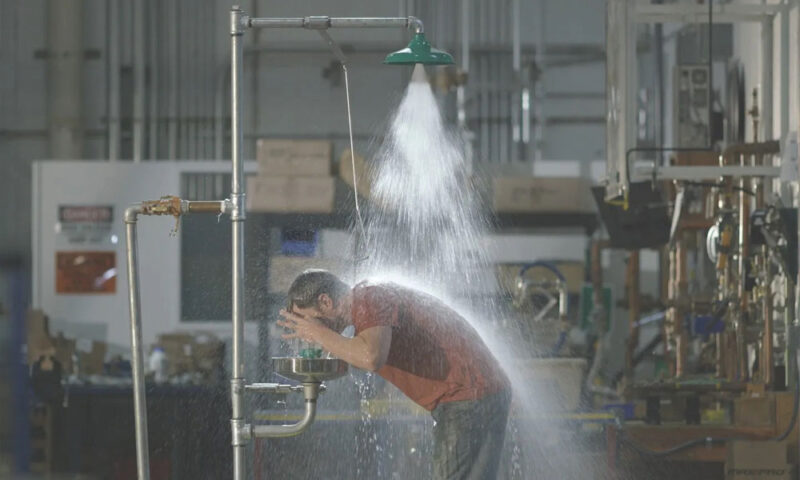In the hazardous environment of American chemical plants, the strategic placement of safety eyewash stations is crucial for ensuring worker safety and compliance with regulatory standards.
Location and Accessibility
The ANSI Z358 standard stipulates that eyewash stations must be located within a 10-second reach from potential hazard areas. This translates to approximately 55 feet, assuming an average walking speed. However, in chemical plants where hazards are widespread, it’s often necessary to install multiple stations to ensure comprehensive coverage.
Key location considerations include:
- Proximity to hazards: Identify all areas where chemical splashes or exposure risks exist.
- Unobstructed access: Ensure clear pathways to eyewash stations, free from equipment or other obstacles.
- Same-level installation: Place stations on the same level as potential hazards to avoid stairs or slopes in emergencies.
- Visibility: Install in well-lit, clearly visible locations with appropriate signage.
- Logical placement: Position near exits, in corridors, or other intuitive locations where workers would naturally seek help.
Flow Rate and Duration
ANSI standards require eyewash stations to deliver a minimum flow rate of 3 US gallons (11.4 liters) per minute for 15 minutes. This specification ensures thorough decontamination of the eyes and face in case of chemical exposure. For combination units that include both eyewash and safety shower functions, the shower component must deliver a minimum of 20 US gallons (76 liters) per minute for the same 15-minute duration.
To meet these requirements, chemical plants should consider:
- Water supply capacity: Ensure the facility’s water system can maintain the required flow rates for all installed units.
- Pressure regulation: Install pressure-regulating valves to maintain consistent flow regardless of fluctuations in the main water supply.
- Tepid water supply: Provide water at a comfortable temperature (between 60°F and 100°F) to encourage full duration use if needed.
Multiple Protections to Enhance User Safety
Chemical plants present various hazards, and eyewash stations should offer multiple layers of protection:
- Anti-scald protection: Implement thermostatic mixing valves to prevent burns from excessively hot water.
- Backflow prevention: Install backflow preventers to maintain water quality and prevent contamination of the potable water supply.
- Freeze protection: For outdoor or unheated areas, use freeze-resistant models or heat-traced piping.
- Chemical-resistant materials: Construct stations using materials that withstand corrosive environments.
Variety of Options for Different Plant Areas
Chemical plants often have diverse environments with varying space constraints and hazard levels. Eagles Safety offers a range of eyewash station options to accommodate these needs:
- Wall-mounted units: Space-saving options for tight corridors or small rooms.
- Pedestal-mounted stations: Freestanding units for flexible placement in open areas.
- Combination units: Integrating both eyewash and safety shower functionalities for comprehensive decontamination.
- Portable eyewash stations: For remote areas or as supplementary units during maintenance operations.
- Laboratory-specific models: Designed to fit in cramped lab spaces while meeting all safety requirements.
Maintenance and Testing
Regular maintenance is essential to ensure eyewash stations function properly when needed:
- Weekly activation: Flush the system to ensure proper operation and maintain water quality.
- Monthly inspections: Check for leaks, pressure issues, and overall functionality.
- Annual thorough inspection: Conduct a comprehensive check of all components, including flow rates and water temperature.
- Documentation: Maintain logs of all inspections and maintenance activities for regulatory compliance.
Training and Awareness
Effective use of eyewash stations relies on proper training and awareness among all plant personnel:
- Initial training: Provide comprehensive instruction on eyewash station locations and proper use during employee onboarding.
- Regular drills: Conduct periodic emergency response drills to familiarize workers with eyewash station activation and use.
- Refresher courses: Offer annual refresher training to maintain awareness and update on any changes to equipment or procedures.
- Visitor protocols: Establish procedures for informing visitors about the locations and use of eyewash stations.
Conclusion
Implementing safe and effective eyewash stations in American chemical plants requires careful consideration of location, performance, and usability factors. By adhering to ANSI standards and leveraging the expertise of manufacturers like Eagles Safety, chemical plants can create a comprehensive emergency response system that protects workers from potentially devastating eye injuries. Regular maintenance, coupled with thorough training and awareness programs, ensures that these critical safety devices remain ready to perform when seconds count.

